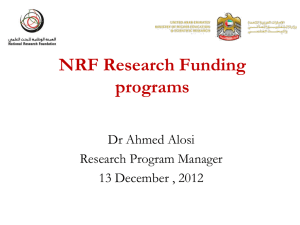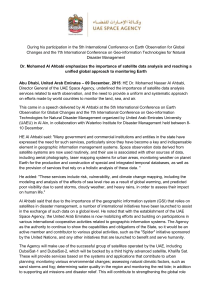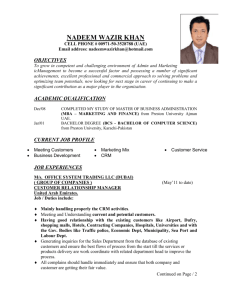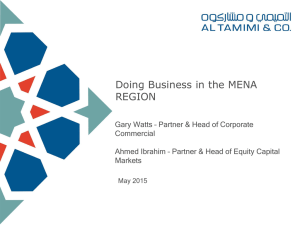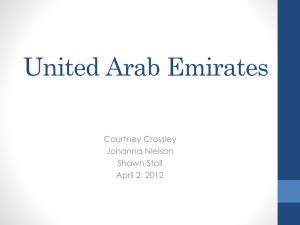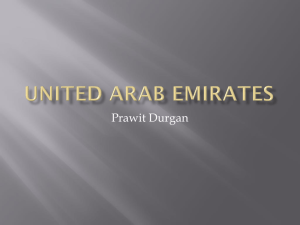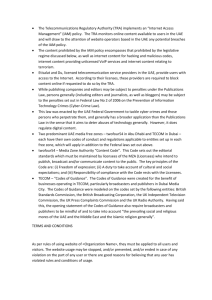Full Presentation
advertisement
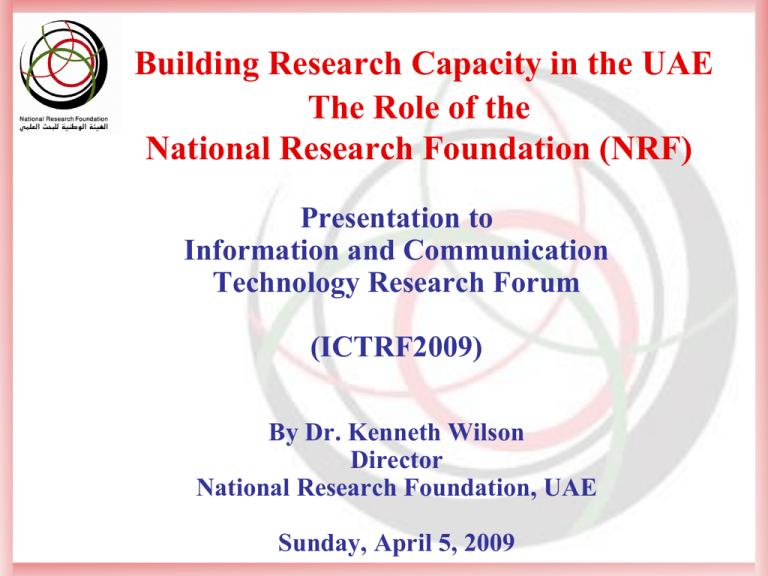
Building Research Capacity in the UAE The Role of the National Research Foundation (NRF) Presentation to Information and Communication Technology Research Forum (ICTRF2009) By Dr. Kenneth Wilson Director National Research Foundation, UAE Sunday, April 5, 2009 Objectives To enable the participants to better understand: UAE research performance. The Knowledge Economy. The National Innovation System (NIS). National Research Foundation (NRF) Slide 2 UAE Research Performance The United Arab Emirates is the 66th ranked producer of scientific publications in the world in 2006, but 87th in publication impact as measured by the h-index. UAE experienced steady growth in output through 2005, but its share of global and regional output is now in decline. UAE has not matched the exceptional growth experienced in Iran or Egypt. Indicator Value Global Rank Regional Rank Publication 7202 66 7 44 87 7 h-index Source: SRI International Slide 3 MENA Scientific Publications Source: SRI International Slide 4 UAE Research Publications by Institution Publications 2000-2006 Average Impact United Arab Emirates University 1758 3.41 American University of Sharjah 252 1.88 University of Sharjah 197 2.37 Tawam Hosp 161 2.69 Mafraq Hosp 68 1.65 Khalifa University (Etisalat College) 67 3.75 Central Vet Research Lab 65 4.26 University Source: SRI International Top Fields Biochemistry & Molecular Biology Engineering, Chemical Cell Biology, Obstetrics & Gynecology, Pediatrics Engineering, Electrical & Electronic Mathematics, Applied Computer Science, Interdisciplinary Engineering, Electrical & Electronic Mathematics, Applied Mathematics Medicine, General & Internal Pediatrics Surgery Radiology, Nuclear Medicine & Medical Imaging Rheumatology Ophthalmology Mathematics, Applied Engineering, Electrical & Electronic Mathematics Veterinary Sciences Reproductive Biology Food Science & Technology Slide 7 What is the Knowledge Economy? “A knowledge-driven economy is one in which the generation and exploitation of knowledge play the predominant part in the creation of wealth” (UK Department of Trade & Industry, 1998). Economic prosperity depends upon knowledge creation and learning. Knowledge includes know-what know-why know-who know-where know-when Slide 10 What is Knowledge Economy? (Cont.) A company’s intellectual capital is embodied in its employee’s knowledge, brainpower and processes. The ability to continuously improve these processes is a source of competitive advantage. the enablers of knowledge creation ICTs are tools for releasing the creative potential and knowledge embodied in people. Slide 11 Measuring the Knowledge Economy The World Bank Knowledge Assessment Methodology identifies four pillars of the Knowledge Economy: • Pillar1 • Pillar4 • Pillar2 Economic and institutional regime Education and skills Innovation system ICT infrastructure • Pillar3 Slide 12 Knowledge and Innovation Rank for GCC Countries among world countries Knowledge Rank among 140 countries Country KEI Innovation’s Rank among 134 countries KI Country Bahrain 49 53 Kuwait 50 54 Oman 62 Qatar Quality of Universityscientific research industry research institutions collaboration Bahrain 100 101 Kuwait 54 73 73 Oman 59 39 45 49 Qatar 30 25 Saudi Arabia 65 68 Saudi Arabia 47 37 UAE 42 42 UAE 74 58 Source: The Knowledge Assessment Methodology (KAM) 2008 rankings for 140 countries, The World Bank Institute Source: The Global Competitiveness Report 2008-2009, World Economic Forum Executive Opinion Survey 2007, 2008 Slide 13 Education Rank for GCC Countries among 134 countries Country Quality of Primary Education Secondary Enrollment Tertiary Enrollment Quality of the Educational System Bahrain 65 19 64 56 Kuwait 92 60 88 94 Oman 43 62 77 51 Qatar 22 23 85 16 Saudi Arabia 75 39 70 70 UAE 39 56 79 38 Source: The Global Competitiveness Report 2008-2009, World Economic Forum Executive Opinion Survey 2007, 2008 Slide 14 What is Innovation? Innovation is the conversion of knowledge and ideas into a benefit, which may be for commercial use or the public good; the benefit may be new or improved products, processes or services. Source: http://www.milmi.org/admin/uploadedPublications/1296_Innovation_Indicator_Report_2007.pdf According to Cutler (2008): Innovation is commonly described as ‘creating value by doing things differently’; or doing something in a novel way’. Simply it is ‘good ideas put to work’ Slide 17 Innovation is a process of continuously generating and applying new ideas. Innovation is one of the key drivers of economic growth. Innovation Innovation is essential to the competitiveness and sustainability of an economy and society. Innovation complements and facilitates the knowledge creation and application process. Slide 18 What does NIS meanof forInnovation individual researchers? Categories Product Innovation Science-Led CustomerDriven Radical Solar Panel Water Heating Internet Search Engines Incremental More HomeEfficient or delivered Cheaper Pizzas Solar Panels Process Innovation Technological Genetically Modified Crops Organizational Toyota’s Total Quality Management Reducing A more Efficient Evaporation in Pay or Bonus Irrigation System Systems 20 Slide20 Innovation is a Dynamic, Evolving and Learning Process According to Cutler (2008) there are three highly interdependent functions within an innovation system: • knowledge production (the origination of new knowledge and ideas); • Knowledge application (the deployment of knowledge and ideas in the real world); and • Knowledge diffusion (the absorption of this applied knowledge and its adaptation in use). Slide 23 The Systemic Elements the Innovation Process What does NIS meanoffor individual researchers? Origination or Adaptation Knowledge Diffusion Diffusion and Absorption Knowledge Production Policies for a Robust National Innovation System Deployment Knowledge Application 24 Source: Terry Cutler, Venturous Australia, 2008 Slide24 The National Innovation System (Cont.) Innovation is built on stocks of knowledge and capability, and the information flows of the innovation capital around these. Innovation Policy is a central part of Economic policy. A successful NIS invests in each innovation stock component as well as in the flows and linkages between them. A NIS incorporates regional and sectoral clusters of activity: RIS and SIS. This is where Ankabut will play a key role. Within a globalized economy, a NIS also needs to be positioned within a global innovation ecosystem. This is Slide 25 also where Ankabut will play a key role. WhatInnovation does NIS mean for individual researchers? Stocks and Flows Stocks Flows Human Capital Social Networks Institutions Trusted transactions Facilities (plant and equipment) Fitness for purposes; access and Operability Information and data Access; freedoms to use and adapt Source: Terry Cutler, Venturous Australia, 2008 26 Slide 26 What does NIS mean for individual researchers? The Innovation Landscape Governance & Institutional Alignment National Innovation Priorities Entrepreneurial Firms and Innovative Sustainable National Workplaces Prosperity and Wellbeing Human Capital and Social Networks Information flows and Freedoms to Innovate Supporting Infrastructure Global Integration Market Design and Regulation 27 Source: Terry Cutler, Venturous Australia, 2008 Slide 27 What is the National Research Foundation (NRF) in the UAE? Slide 28 28 NRF Vision To support world-class research activities, and create an internationally competitive research environment and innovation system in the United Arab Emirates. NRF Mission To build an internationally competitive research capacity for the economic and social development of the United Arab Emirates. Slide 29 NRF will Fund research activity consistent with national priorities; Boost research performance and create world-class research Centers in the country; Encourage collaborative research activity between public and private universities, and industry; Create new knowledge that leads to economic and social benefits in the UAE; Facilitate the transfer of knowledge into economic and social activity; Improve the UAE’s international benchmarking on Research and Development. Slide 30 NRF at a glance Small organization; focused and flexible; Providing research leadership and advice; Investing in research in UAE universities; Facilitating research networks & partnerships; Helping to build an innovation culture and national innovation system; Assisting industry and commerce grow its research activities; Raising awareness of the importance of research. Slide 32 32 NRF Stakeholders The Federal Institutions UAEU, Zayed University, HCT CAA Accredited Institutions 58 heterogeneous “Private” universities and colleges Slide 33 33 NRF Awards Research Excellence Centers, 2008 • Four Centers established from 18 proposals: • Water & the Environment • Genes and Diseases • NanoScinece & NanoEngineering • Bilingualism & Bilingual Education Research & Scholarship Awards, 2009 • 653 Pre-proposals submitted from 33 institutions. Expect to fund 100-150 proposals. 34 Slide 34 NRF’s 2009 Research & Scholarship Awards: Pre-proposal Submissions by Domain Domain Number of Pre-proposal Submissions Agricultural Sciences 16 Biological Sciences 13 Business Management 57 Chemical Sciences 22 Computer and Information Science Engineering 88 Earth Sciences 10 Ecology and Environmental Sciences 26 Economics, Finance, and Accounting 48 Engineering 127 Humanities and Cultural Studies 33 Material Science and Engineering 22 Medical, Dental, and Veterinary Sciences 103 Physical Sciences and Mathematics 29 Social Sciences 59 Total 653 Slide 35 National Research Priorities? Emerging Research Opportunities Environment - Water, soil/desert - Air pollution & dust Health - Genetic diseases - Diabetes and obesity Energy - Petroleum extraction and downstreaming - Solar and other alternatives Education - K-12 - Science & Math Transport, Logistics & Tourism - Air, sea and auto Risk management and distribution Sustainable cities - Sustainable buildings Sustainable roads and infrastructure Innovation & Entrepreneurship - Knowledge Economy - NIS, RIS, SIS, GI Ecosystem Culture and Religion - Social change and cultural tensions - Religion and pluralism Slide 36 Conclusion Thank you for listening patiently Now for Questions! Slide 37 37



